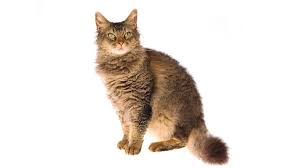
LaPerm
Conditions of detention
LaPerms are adaptable and thrive in various living environments, from apartments to larger homes. They enjoy being part of family activities and require an environment where they can interact with their human companions.
Useful Fact:
LaPerms are known for their social and affectionate nature. They often seek out attention and enjoy being involved in daily activities, making them excellent companions for families and individuals alike.
Nutrition and diet
LaPerms require a balanced diet consisting of high-quality cat food that includes the right mix of proteins, fats, vitamins, and minerals to support their energy levels and overall health. It’s important to provide fresh water at all times and monitor their weight to prevent obesity.
Useful Fact: Some LaPerms may prefer wet food over dry food, which can also help with hydration.
Health
LaPerms are generally healthy cats with few breed-specific health issues. Regular veterinary check-ups, vaccinations, and preventative care are essential to keep them healthy. Common issues to watch for include dental disease and obesity.
Useful Fact: LaPerms have a longer average lifespan compared to some other breeds, often living up to 15 years or more with proper care.
Grooming and care
Despite their curly coats, LaPerms have relatively low grooming needs. Weekly brushing can help prevent matting and reduce shedding. Regular nail trimming, ear cleaning, and dental care should also be part of their grooming routine.
Useful Fact: LaPerms tend to shed less than other breeds, making them a good choice for people with mild allergies.
Education and training
LaPerms are intelligent and can be trained to perform tricks, use a litter box, and follow basic commands. Positive reinforcement and consistency are key to successful training.
Useful Fact: LaPerms are known for their problem-solving abilities and can often figure out how to open cabinets or doors.
Toys and entertainment
LaPerms enjoy interactive toys, puzzle feeders, and climbing structures. Providing a variety of toys can help keep them mentally and physically stimulated.
Useful Fact: LaPerms often enjoy playing fetch, similar to dogs, and can be trained to bring back thrown toys.
Safety
Indoor living is recommended for LaPerms to keep them safe from outdoor hazards such as traffic, predators, and diseases. Ensure windows and balconies are secure to prevent accidents.
Useful Fact: LaPerms are curious and may try to explore small spaces, so it’s important to cat-proof your home.
Accessories
Essential accessories for a LaPerm include a sturdy scratching post, comfortable bedding, litter boxes, and grooming tools. Interactive toys and climbing trees are also beneficial.
Useful Fact: LaPerms love high vantage points, so providing cat shelves or tall cat trees can enhance their environment.
Socialization
LaPerms are naturally sociable and thrive on interaction with their human families and other pets. Early socialization helps them develop into well-adjusted adults.
Useful Fact: LaPerms often follow their owners around the house and enjoy being involved in daily activities.
Travel and Transportation
LaPerms can adapt to travel if introduced to it gradually. Using a secure carrier and providing familiar items like a blanket or toy can help reduce travel stress.
Useful Fact: Some LaPerms enjoy car rides and may even look out the window during trips, making them good travel companions.
Behavior and psychology
LaPerms are known for their affectionate and playful nature. They are often described as dog-like in their loyalty and desire for companionship.
Useful Fact: LaPerms can be vocal and expressive, using a range of sounds to communicate with their owners.
Legal aspects
Before acquiring a LaPerm, check local regulations regarding pet ownership, such as licensing and microchipping requirements. Responsible breeding practices and adherence to animal welfare laws are also important considerations.
Useful Fact: LaPerms are a recognized breed by major cat registries, including The International Cat Association (TICA) and the Cat Fanciers’ Association (CFA).


